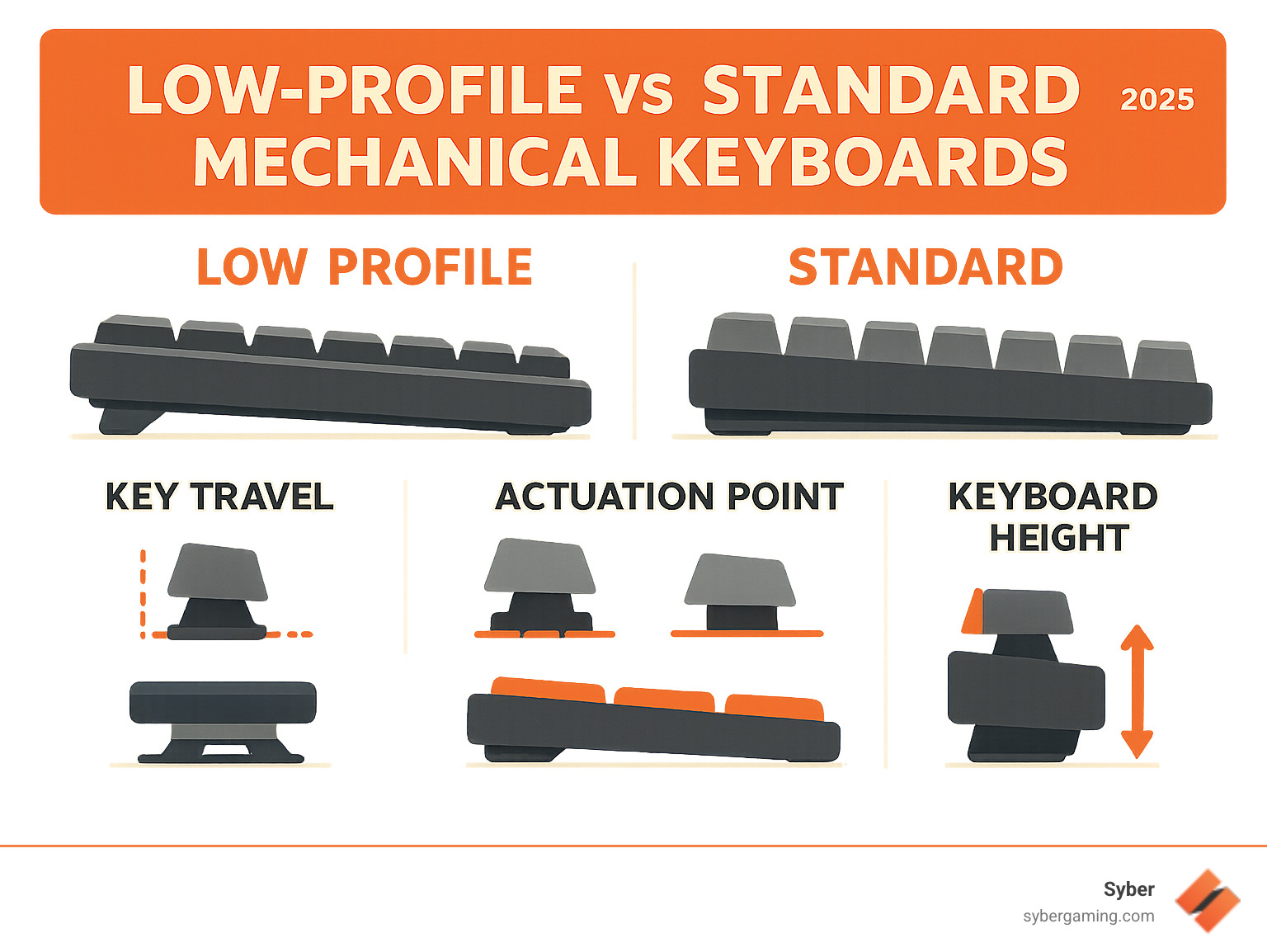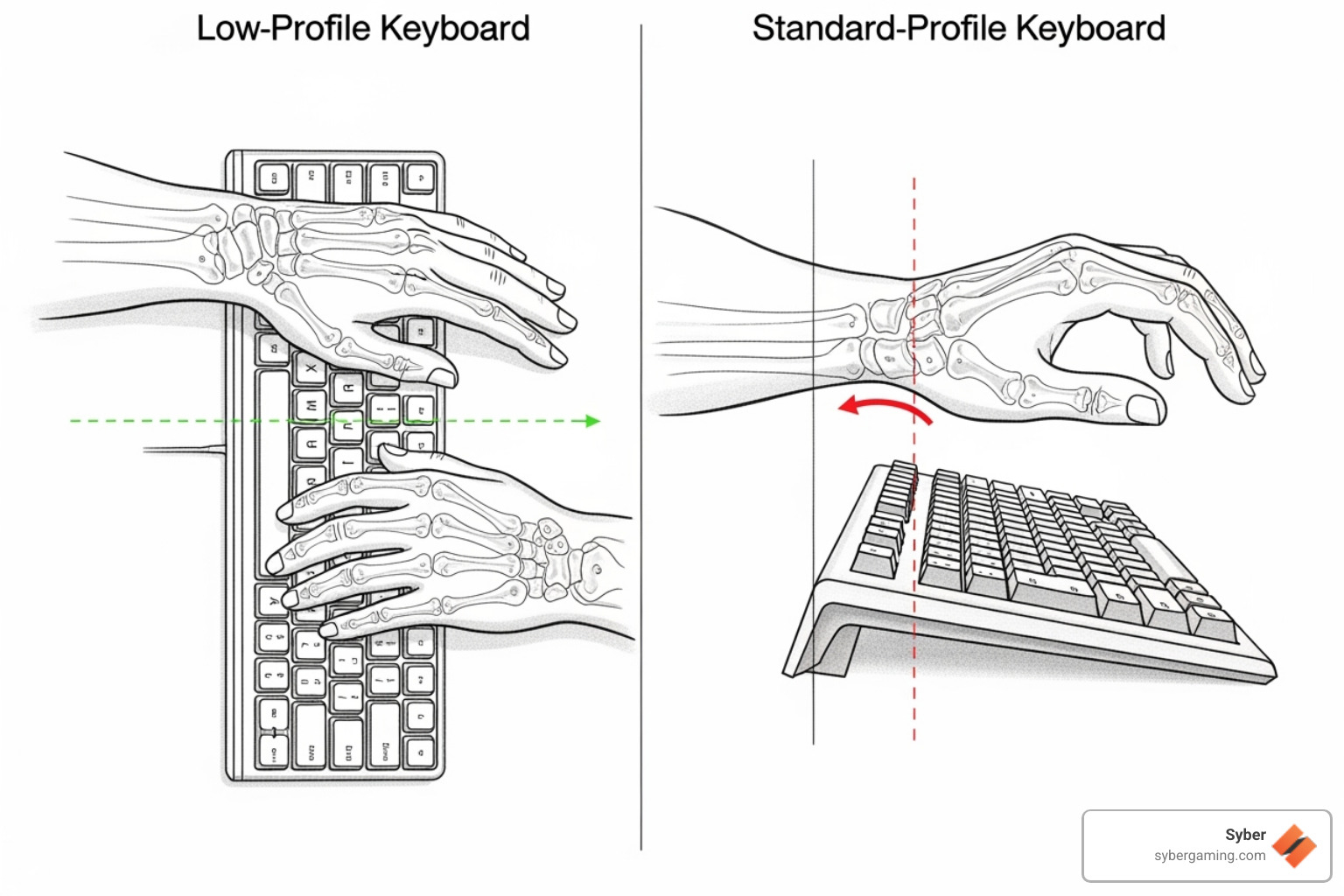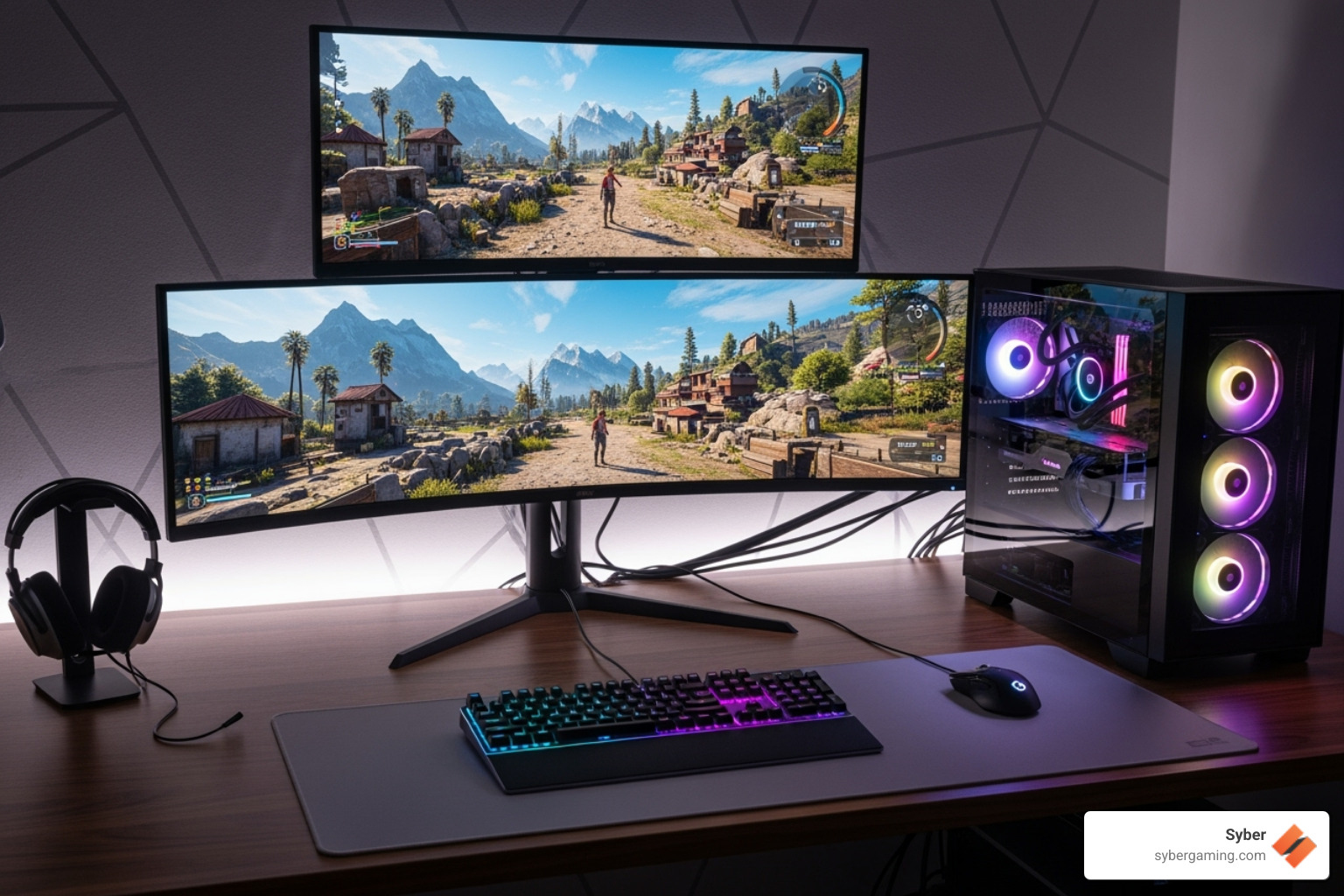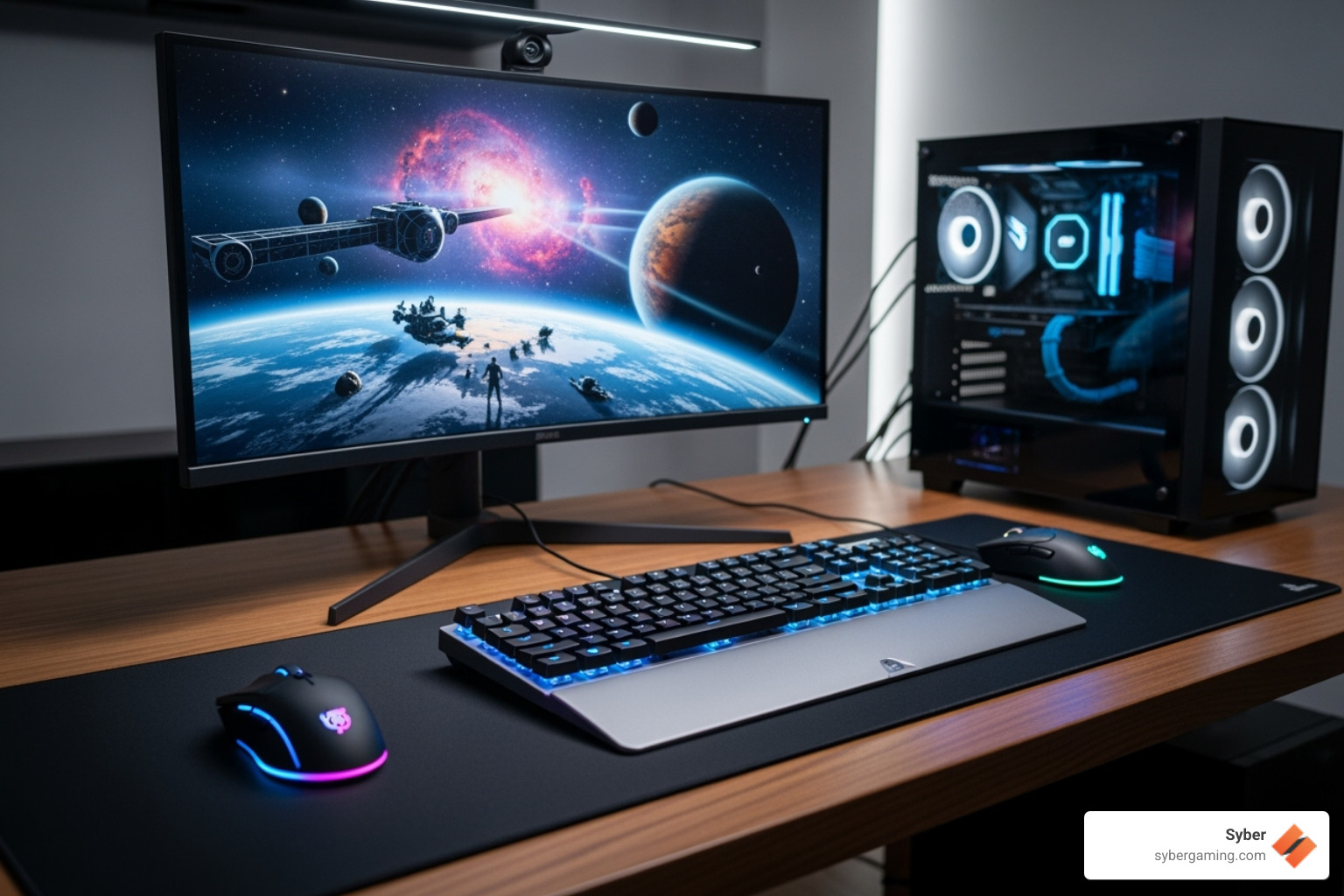The Skinny on Slim Keyboards
For a long time, the gaming world has debated whether are low profile keyboards better for gaming, or if their bulkier, traditional cousins hold the crown. The truth is, it's not a simple yes or no. Modern low-profile keyboards bring distinct advantages and some trade-offs.
Here’s a quick look at what you need to know:
- Speed: Often feature shorter key travel and actuation, leading to faster response times and reduced input lag.
- Comfort: Their slimmer design can promote a more neutral wrist position, reducing strain during long gaming sessions.
- Portability: Much easier to carry for gamers who play on the go or prefer minimalist setups.
- Feel: May require an adjustment period for those used to the deeper key presses of traditional mechanical keyboards.
- Customization: Generally offer fewer options for aftermarket keycaps and a more limited variety of switches compared to traditional keyboards.
Gaming keyboards have evolved dramatically. We've seen them go from simple tools to complex pieces of tech that can define your setup. But through all this change, low-profile keyboards often faced skepticism. Many gamers were wary of their past performance.
But things have changed. Today's low-profile mechanical keyboards are sleek, performant, and challenging old ideas. They are no longer just for looking good or saving space. They're built to compete.

Are low profile keyboards better for gaming terms at a glance:
Are Low Profile Keyboards Better for Gaming? A Performance Deep Dive
When evaluating if are low profile keyboards better for gaming, one must dive deep into the technical specifications and real-world impacts. The shift from traditional, full-height mechanical keyboards to their slimmer counterparts isn't just about aesthetics; it's about a fundamental change in how keys register input, which can directly affect a gamer's performance.
The Speed Advantage: Faster Keystrokes, Faster Frags
The most compelling argument for low-profile keyboards in gaming revolves around speed. These keyboards are engineered to deliver faster response times, and here's how they achieve it:
The core difference lies in the mechanical switches themselves. Low-profile mechanical switches are significantly shorter—about 30% to 40% shorter than their normal-profile counterparts. This reduced height translates directly into shorter key travel. While a normal profile switch typically has a total travel of 4.0 mm, low-profile switches often boast a total travel of just 2.5 mm to 3.0 mm.
What does this mean for gamers? Less distance for the key to travel equals faster actuation. The pre-travel distance, which is how far you need to press a key before it registers an input, is also dramatically reduced. Normal profile switches usually have a pre-travel of around 2.0 mm, but low-profile switches can actuate in as little as 1.5 mm to 1.7 mm. This means low-profile switches can be triggered in half the time compared to normal profile switches, with their actuation points reduced by half.
For gaming genres like First-Person Shooters (FPS) and Multiplayer Online Battle Arenas (MOBA), where milliseconds can determine victory or defeat, this shorter key travel and reduced actuation point translate into a tangible in-game advantage. Players experience quicker response times and reduced input lag, allowing for snappier reactions and more precise movements. It’s like the difference between doing full squats versus half squats—less effort, same results, but much quicker.
Furthermore, advancements like Hall effect switches in some low-profile keyboards allow for adjustable actuation distances. This means gamers can fine-tune the sensitivity of their keys to their exact preference, enabling extremely sensitive and quick responses with tight actuation and reset points. Combined with high polling rates, often well above the standard 1000Hz, low-profile mechanical keyboards can truly complement a high performance gaming pc build, ensuring that the keyboard doesn't become a bottleneck for an otherwise powerful system driven by advanced AI gaming technology and AI-driven performance.

Built for the Grind: Superior Ergonomics and Comfort
Beyond raw speed, the ergonomic benefits of low-profile keyboards are a significant factor in determining if are low profile keyboards better for gaming, especially for those who spend extended periods at their desks.
The slimmer design of low-profile keyboards naturally promotes a more neutral wrist position. Unlike traditional keyboards, which often require your hands to angle upwards, low-profile models allow your palms to rest comfortably on the desk. This reduces the sharp wrist angle that can lead to strain and discomfort during marathon gaming sessions. Many users report a significant reduction in wrist pain, with some even finding their discomfort disappearing within weeks of making the switch.
This ergonomic advantage means less fatigue over long gaming sessions, helping to prevent repetitive strain injuries (RSI). With a low-profile keyboard, you often don't even need a separate wrist rest, as the keyboard's inherent design supports a more natural hand position. This makes them a key component in any Ultimate Gaming Keyboard Guide focused on long-term comfort and player well-being. By maintaining a neutral hand position, gamers can focus more on their gameplay and less on discomfort, contributing to a more consistent and enjoyable experience. The investment in ergonomic design truly pays real dividends over time.

The Adjustment Period: What are the drawbacks of low profile keyboards for gaming?
While the benefits of low-profile keyboards for gaming are compelling, it's also important to address their potential drawbacks and challenges. The transition isn't always seamless, and certain aspects might not appeal to every gamer.
One of the most common points of contention is the key feel. Low-profile keyboards, with their shorter key travel, have a distinctly different feel compared to traditional mechanical keyboards. For users accustomed to the deep, satisfying keystrokes of full-height switches, the shallower feel of low-profile keys can initially feel less substantial or even less tactile. This can lead to an adjustment period, during which some gamers might even experience a temporary dip in performance or an increase in typos until they adapt to the new sensation. It takes time to get used to this specific key feel, particularly for gaming purposes. Some gamers might feel that the lower key height is not comfortable for them, or they might simply prefer the classic, more pronounced feedback of standard mechanical keys.
Another challenge lies in customization. Compared to the vast ecosystem of traditional mechanical keyboards, low-profile options generally offer fewer choices in terms of switches and aftermarket keycaps. While there are popular low-profile switch types like Kailh Choc and Cherry MX Low Profile, the overall variety is smaller than what's available for normal-profile switches. Furthermore, low-profile keyboards often have unique keycap sizes, which severely limits options for personalization or replacement, unlike the almost universal compatibility found with standard keycaps. This can be a drawback for hardware enthusiasts who enjoy modifying their gaming setup.
Regarding durability, while some perceptions might lean towards thinner components being less robust, modern low-profile mechanical switches are designed to be equally durable and capable for prolonged use as their traditional counterparts. Many are rated for millions of keystrokes, matching industry standards. However, the perception of their fragility, combined with the limited customization options, can sometimes lead to an initial apprehension among gamers, who have every right to be wary of low-profile keyboards from the past. Yet, modern engineering has largely addressed these concerns.
Finding Your Perfect Match: Which Gamers Benefit Most?
Understanding who benefits most from low-profile keyboards is crucial when considering if are low profile keyboards better for gaming for your specific needs. Not every gamer is the same, and preferences vary widely.
Low-profile keyboards are particularly well-suited for several gamer profiles:
- Laptop Gamers: For those accustomed to the slim, short-travel keyboards found on laptops, low-profile mechanical keyboards offer a familiar yet significantly upgraded experience. They provide the tactile feedback and responsiveness of mechanical switches in a form factor that feels natural. Laptop gamers know the struggle of having to use their laptop keyboard for gaming on the go, and a low-profile external keyboard solves this perfectly.
- Competitive Players: The core advantage of faster actuation and reduced input lag makes low-profile keyboards highly appealing to competitive gamers in genres like FPS and MOBA, where every millisecond counts. Their ability to deliver quicker keystrokes can provide a tangible competitive edge, helping them maximize the performance of their AI-ready gaming PC.
- Minimalist Enthusiasts: Gamers who prefer a clean, uncluttered desk setup will appreciate the sleek aesthetics and compact design of low-profile keyboards. They blend seamlessly into modern gaming spaces and are easy to maintain.
- On-the-Go Gamers: Portability is a huge win for low-profile keyboards. Their lighter weight and reduced thickness make them ideal for gamers who frequently travel, attend LAN parties, or simply move their setup between locations. Slipping one into a backpack is far easier than trying to transport a bulky, full-height keyboard safely.
However, low-profile keyboards might not be for everyone. Some gamers still prefer traditional mechanical keyboards for various reasons. Those who enjoy the deep keystrokes, pronounced tactile feedback, and the wide array of switch types and keycap customization options might find low-profile keyboards less satisfying. Every gamer has their own preferences, and some simply find the longer travel and more substantial feel of traditional keyboards more comfortable or gratifying.
The role of wireless technology in low-profile keyboards has also expanded their appeal. Modern wireless low-profile mechanical keyboards are a viable option for competitive gaming. While battery life and potential latency were once major concerns, advancements have largely mitigated these issues. Many models now offer tri-mode connectivity (Bluetooth, 2.4GHz wireless, and USB-C wired), allowing gamers to choose the best option for their situation. For competitive play, the 2.4GHz wireless connection is often preferred over Bluetooth due to its lower latency, providing raw gaming performance that rivals wired connections. Battery life has also improved significantly, with some models offering up to 40 hours of continuous use even with backlighting enabled. This flexibility means that gamers can enjoy the benefits of a compact, responsive keyboard without being tethered to their pre built for gaming setup.
The Final Verdict: Should You Go Low-Pro for Your Gaming Rig?
Alright, after diving deep into slim key-pressers, the big question still stands: are low profile keyboards better for gaming? The honest answer, like so many things in the changing world of PC gaming, truly comes down to what you prefer and what you need. There's no one-size-fits-all keyboard.
Let's quickly recap the good stuff. Low-profile keyboards offer some serious advantages. Their shorter key travel and quicker actuation points can genuinely shave off milliseconds, giving you a noticeable edge in games where every moment counts. Think about those crucial headshots or perfectly timed spells – speed is king. Beyond that, their slimmer design naturally encourages a more relaxed, neutral wrist position. This can be a game-changer for marathon sessions, reducing strain and keeping you comfortable for hours. And if you're someone who likes a clean, minimalist desk, or if you frequently take your gear to LAN parties, their sleek, compact size is a huge bonus.
But, like any good sidekick, they do have their quirks. The different key feel, with its shallower press, takes some getting used to. If you're a long-time fan of the deep, satisfying thunk of traditional mechanical keyboards, this might feel a bit less substantial at first. Plus, if you love customizing your rig with unique keycaps and a huge variety of switches, you might find fewer options in the low-profile world. It's a trade-off, but one that many gamers are finding worth it.
Your keyboard isn't just an accessory; it's a vital extension of your gaming ability, a direct link to the action. Just as you carefully choose the powerful components for a high performance custom prebuilt gaming pc, your keyboard needs to match your unique playing style and comfort needs. Whether you're planning a custom build gaming pcs project or browsing pre built gaming computers for your next setup, considering a low-profile keyboard is no longer a niche idea. It's a legitimate, high-performance contender in the modern gaming landscape.
So, for the competitive player chasing every possible advantage, the gamer who prioritizes comfort during long sessions, or the enthusiast who loves a sleek, uncluttered setup, a modern low-profile mechanical keyboard is absolutely worth exploring. They’ve truly shed the old stigma, proving that a slim design can pack a serious punch and deliver strong performance.

Your keyboard should always match the raw power and performance of your AI-ready gaming PC. Ready to see what's out there? Explore the best mechanical keyboards for your setup, like the K1 Mechanical Keyboard.
Ready to lift your gaming experience with a high-performance custom prebuilt gaming PC and the perfect keyboard to match? Visit Syber Gaming today and find the difference expert craftsmanship makes.






.svg)

